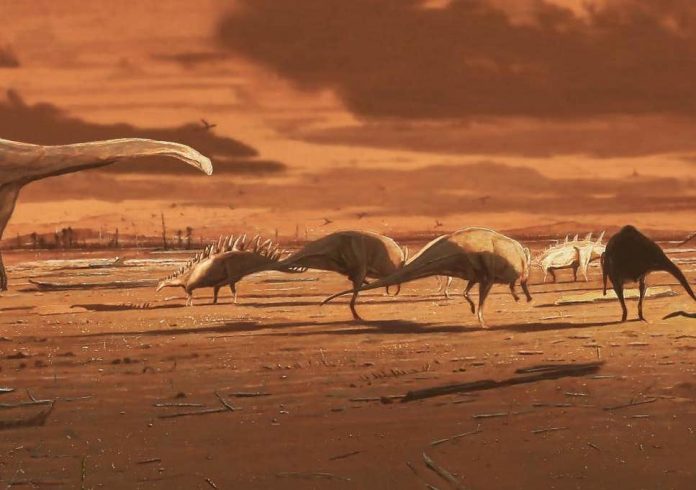Scientists have discovered footprints left by stegosaurus dinosaurs 170 million years ago on the Isle of Skye, the first evidence the iconic creatures once lived in Scotland.
A team of palaeontologists from the University of Edinburgh found the line of grapefruit-sized prints after a storm in 2017 pushed aside boulders that had hidden them for years.
The triangular footprints were left by a stegosaurus about the size of a cow as it walked along a mudflat next to what was then a shallow lagoon, 170 million years ago.
Today, the site is known as Brothers Point on the north eastern coast of Skye, which has acquired the nickname Dinosaur Isle thanks to the number of fossils found.
Researchers identified a line of prints in a right-left pattern and in two different sizes, which indicate the gait of a four legged animal with smaller front feet.
“These footprints are the first evidence we have that this very major, very iconic group of dinosaurs lived in Scotland,” Dr Stephen Brusatte, one of the palaeontologists who led the research, told The Guardian.
Writing in the journal Plos One, the team explain they also found about 50 other dinosaur prints at the same location, revealing the coastal mudflats were home to a thriving community of animals.
Stegosaurs are among the most well-known dinosaurs, famous for their iconic diamond-shaped plates, which protrude along their backs, and a dangerous-looking spiked tail.
Although the largest stegosaurus species could grow up to nine metres long and weigh 30 tonnes, the particular dinosaur that left its footprints behind at Brothers’ Point was much smaller and could have been a youngster.
Dr Brusatte said the findings shed light on what life would have been like on the Isle of Skye during the mid-Jurassic period, about 170 million years ago.
““It would have been overrun with … so many different types of dinosaurs: meat-eaters, plant eaters, big ones, small ones, ones that were running around, ones that were wading in the water, ones that had long necks, ones that had plates on their backs.
“It was an island in the middle of the ever-widening Atlantic with this subtropical, wet, humid, hot climate with rivers draining mountains in the middle of the island, emptying out into the ocean; and then beaches and lagoons fringing the coasts — and these places were havens for dinosaurs and for all kinds of other species.”
Because fossils from this era are relatively rare worldwide, the Skye finds are very important evidence for palaeontologists trying to better understand dinosaur evolution.
The Scottish government last year issued a Nature Conservation Order for Skye to legally protect the important sites, some of which have already been damaged by private collectors.
Although scientists have been working on Skye for decades since the first dinosaur fossils were found, these footprints were only discovered thanks to a freak storm in 2017 that pushed aside boulders that had been covering them.
The University of Edinburgh team said this emphasised the importance of re-examining even well-studied locations.





























